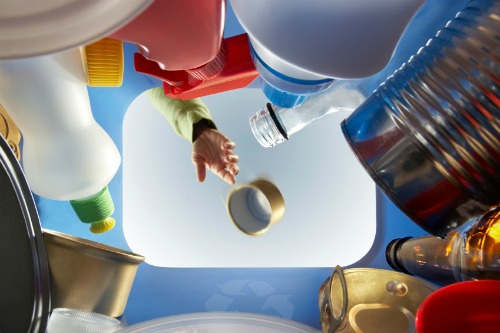Send your question to Umbra!
Q. Dear Umbra,
It seems that commingled recycling could not be as efficient as separated recycling. Although I am aware that it increases the percentage of garbage that is recycled, I wonder if there is any reason to separate my waste and find an old-fashioned recycling center that accepts it.
Michael K.
Adelphi, Md.
 A. Dearest Michael,
A. Dearest Michael,
This here is one of those Hot Topics that is causing entire industries to foam at the mouth, while the rest of us merrily go about our business — sort of like the wood vs. plastic pallet punchfest. On behalf of the recycling industry, I hereby present The Great Commingled Collection Kerfuffle.
A bit of backstory: In commingled (or single-stream) collection, people toss all of their recyclables into one bin, then waste haulers toss it into one truck. Sorting occurs at a materials recovery facility (MRF), which then sends bales of our shredded, crushed cast-offs to be reused. This process was pioneered in Arizona and California in the 1990s, and has spread to hundreds of towns and cities across the country. In the world of waste collection, it is the Next Big Thing.
Why? Because it saves money for cities, which can avoid millions of dollars in landfill fees, and for waste haulers, which have been the muscle behind this shift, and now spend less on trucks, labor, and even workers’ comp claims. On the collection end of things, single-stream recycling saves an estimated $15 per ton of waste.
It’s also a hit with the public (all that sorting was such a strain!): In Stamford, Ct., recycling has increased 70 percent since the city switched to single-stream two years ago. In a pilot program run by one company in southern Nevada, customer participation jumped from 3 percent to 30 percent when single-stream bins were offered. Recycling rates have increased in Austin, Boston, Philadelphia, Cincinnati, and on and on. The numbers keep rolling in.
But guess who despises single-stream recycling to the depths of their boots and back? The recycling industry. That is, the people who actually make new products with our stuff.
The paper industry is particularly peeved because used paper, formerly collected in separate bins, now comes to mills full of plastic and glass shards that can damage equipment, injure workers, and increase costs — not to mention lead to a lower-quality recycled-paper product. One estimate suggests that 15-20 percent of fiber sent to mills contains materials that make it unusable (aka landfill-bound) or require additional processing. All this “progress” costs an estimated $8 more per ton for the mills. (Add that to the $10 additional per ton it takes to sort and process recycled materials at an MRF, and suddenly the magical cost-savingness of single-stream collection isn’t looking so magical or cost-savingy.)
Guess who else is grimacing: People who believe glass should be recycled into glass, not thrown away or crunched up to use in asphalt or as landfill cover. In the course of our current single-stream collection and sorting process, an estimated 40 percent of glass becomes so crushed and contaminated that it ends up in landfills, compared to 10 percent with older recycling methods.
The single-stream industry appreciates these concerns, and asks that we please bear with it, because consumer education and more efficient facilities will surely lead to improvements. Meanwhile, many others are urging municipalities to proceed with caution, tempting as it is to leap at this opportunity.
As to your particular question: If your goal is efficiency, you should probably participate in your neighborhood program, since the truck will be coming either way, while your scheme would require extra and unnecessary driving about town. (I checked with the good folks at Earth911 and Keep America Beautiful, sponsor of America Recycles Day, and both offered advice along those lines.) If you still want to take a small step, you might keep your glass separate and find a place to recycle it — check out the resources offered by Earth911 — perhaps organizing a neighborhood glass drive for maximum efficiency and impact. If you have bigger change in mind, try to learn a little more about your local MRF — why, here’s a page all about yours, Michael! — and the final destination of the materials handled there. Results will vary.
While we’re talking recycling and paper contamination, a note to Nate in Ames, Iowa, and others who have asked if receipts are recyclable: As always, I recommend checking with your local waste agency, but I can tell you that receipts are usually coated with BPA, and evidence including this recent study suggests that BPA can contaminate other recycled-paper products. So avoid accepting receipts when you have the choice, and when they pile up, I give you permission to throw them out. Sometimes it just feels good.
Murfly,
Umbra


